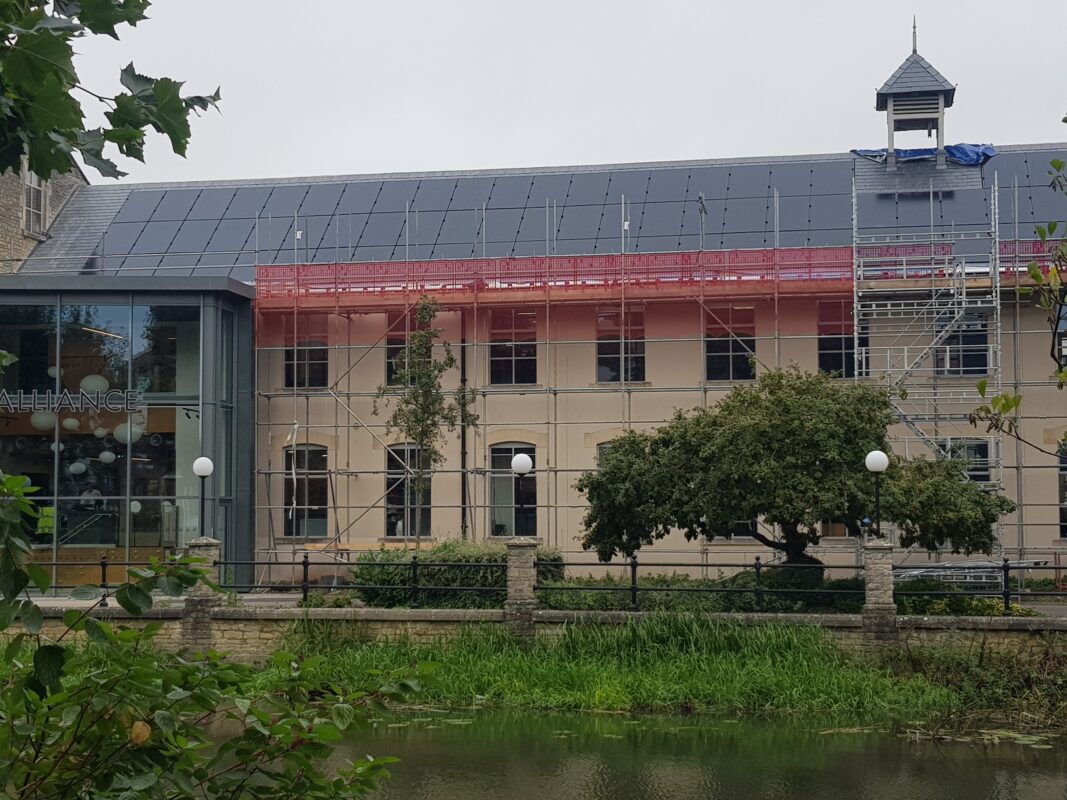So the question is – Can I install Solar Panels on a listed building in the Chippenham conservation area?
Updated – April 2024
The answer is, most likely yes, with a few caveats, but you will need to apply for planning permission. In this post I will look at three recent successful planning applications for Solar Panels on heritage buildings in the Chippenham Conservation area, and one that was refused permission. I fortunately have some insight in this. As as well being one of the administrators for the Zero Chippenham Community Solar scheme, I also currently sit as a Town Councillor on the Planning, Environment, and Transport (PET) committee at Chippenham Town Council. So I have seen a number of planning applications for Solar on heritage buildings come through in the last year, and fortunately all of these have been successful applications.
Firstly let’s recap on the planning rules for Solar Panels…
WILTSHIRE COUNCIL PLANNING GUIDANCE
Wiltshire Council have some information on their website here
You will need planning permission if any of the following are true:
- the equipment would protrude more than 0.2 metres beyond the plane of the wall or the roof slope (when measured from the perpendicular with the external surface of the wall or roof slope)
- the highest part of the equipment would be higher than the highest part of the roof (excluding any chimney)
- the equipment would be installed on a wall which fronts a highway in a conservation area or a World Heritage Site.
- the installation site is designated as a scheduled monument
- the equipment would be installed on a building within the curtilage of a listed building
The installation would be subject to the following conditions:
- equipment would be sited, so far as is practicable, to minimise its effect on the external appearance of the building, and the amenity of the area
- when no longer needed, equipment must be removed as soon as is practicable
The guidance goes on to say…
Solar panels on listed buildings or located within the curtilage of a listed building will nearly always require listed building consent. Those on buildings within their curtilages require usually require planning permission as this would not be considered permitted development under the GPDO.
From the above information it can be seen that in a conservation area planning permission for solar PV is likely to be required. In addition if your building is listed it will most likely also need listed building consent.
Whether the roof you are placing your panels on faces the highway may also be a consideration as to what style of solar installation is allowed.
So where is the Chippenham Conservation area?
The map below is taken from the Chippenham Neighbourhood Plan (copyright credit Chippenham Neighbourhood Plan). The outline in red shows the limits of the Chippenham conservation area. The area is further subdivided into areas of distinct characteristics.
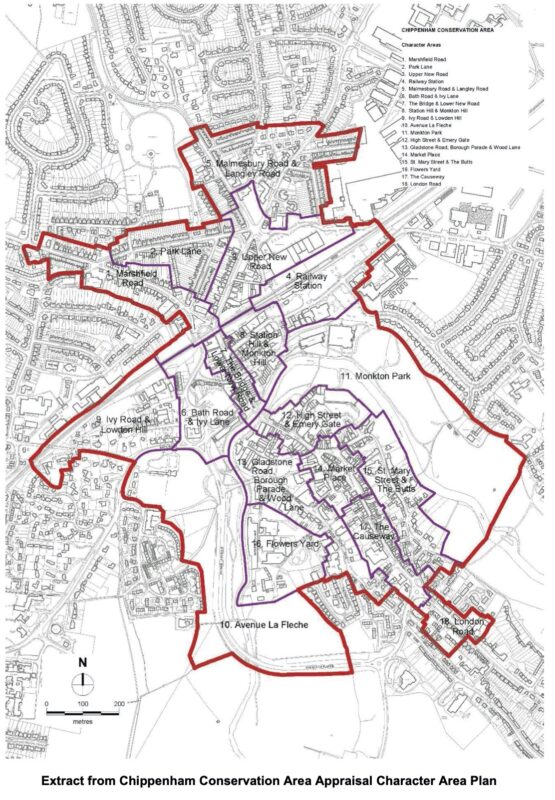
Listed building fronting the highway in Chippenham conservation area
The first example we will look at is a listed building, in the Chippenham conservation area, with a roof area visible to the highway. Planning permission was sought to put solar tiles on the subservient part of the building fronting the highway. You can see the installed solar tiles as the slightly lighter shade in this photo, though in wet weather it is hard to distinguish them.
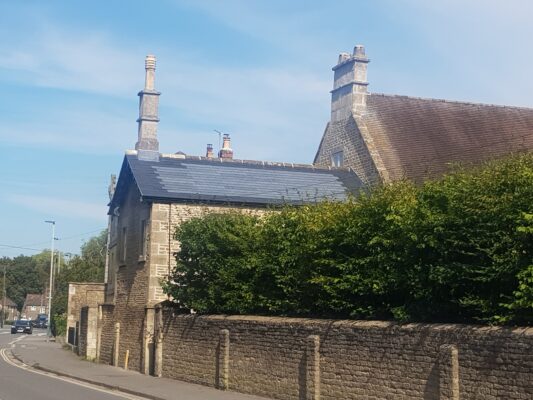
To satisfy the planning officer a number of drawings must be included with a planning application. These usually include:-
- Location drawing
- Existing elevations
- Proposed elevations
- An application form
- A brochure or photos showing visuals of the planned solar installation, in this case a solar tile brochure
- possibly a heritage, design and access statement.
This is quite a lot and it may be advisable to seek an architect familiar with such listed building planning applications. For this application it was Oakley Planning & Conservation.
Wiltshire Council are the planning authority for Chippenham and ultimate decision maker. As part of the consultation process Chippenham Town Council’s PET committee are consulted and give their opinion. As the Town Council have a full time planning officer it’s often the case that the town council’s decision has considerable sway. As such it may be advisable to contact your ward councillor on the PET committee and even turn up to speak at the start of the public meeting. Chippenham Town Council’s planning officer will give professional advice to the PET committee councillors on each application.
You can identify your ward councillor on the PET committee here
In this instance I enthusiastically supported the application. Our planning officer’s comment was recorded as follows.
The proposed development would result in harm to the listed building as a result of the loss of part of its historic fabric, but this would constitute ‘less than significant harm’ and the public benefits of the proposal in reducing the existing carbon footprint are considered to outweigh this harm. In addition, the proposed replacement solar slates would be laid on the roof of the wing, rather than the main building itself.
Fortunately the need to reduce the carbon footprint outweighed the listed building considerations. It undoubtedly helped here that the applicant had chosen solar slates and that the location was subservient to the main roof.
The report from the Wiltshire council Planning officer incorporated the Town Council’s decision and statement and gave a similar weighting to the benefit outweighing the harm, and planning permission was therefore granted.
I spoke with the applicants and asked them about their experience. (Note this was not an application through the Zero Chippenham Scheme)…
We are very pleased with the slates and happy to feature as a case study. We can recommend both GB-Sol (solar slates) and West Country Tiling (roofers). It did cost about the same as buying a small new car to get it done, but we did it to contribute to renewable energy generation, not to save money. It isn’t possible to calculate a payback period just yet (we are with Ecotricity and they are still in the process of getting their feed-in tariff off the ground), but it may be a long period.
West Country Tiling are master tilers normally working with old tiling, but interestingly they chose to undertake our installation contract (their first solar slate job) because they see it as the future too. They priced up a similar installation in Bath shortly afterwards.
We have 3.8kw of generation capacity because of average shading of 40%, plus a 13.1kw battery that fills during the day (if it’s bright enough, doesn’t have to be sunny) . The battery can fulfil our modest background energy needs in the evening and overnight. It doesn’t cover our energy needs for, say, the oven or dehumidifier, or charging the car though.
The colour match with the real slates around the edge is much better in the wet than when dry.
I’m hoping to apply to get the main roof done when the pantiles need replacing in 3-4 years’ time. Replacing like for like as required under the heritage listing will mean new red tiles and that will look quite garish. I would think that solar slates will be preferable for looks, and more consistent with the other listed houses of similar age around us.
The Old Nestle Building
The second example i’ll look at is the building most Chippenham residents refer to as ‘the Old Nestle building’. It is more correctly known as Avonbridge House, and is the headquarters of Chippenham based pharmaceutical company Alliance Pharmaceuticals. The company are leading the way in heritage building modernisation to reduce carbon emissions, and in the process the company’s energy bills. The solar application is the latest on the pathway for the company to reduce its carbon emissions and reduce energy usage and costs.
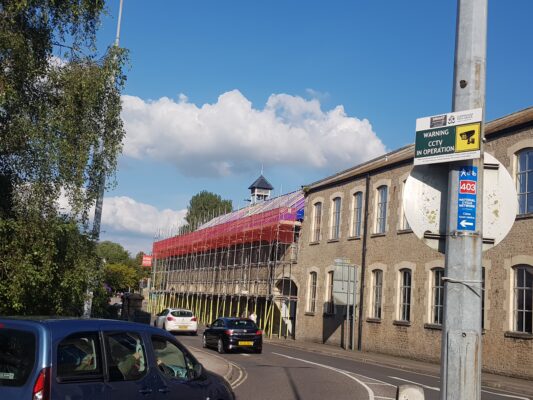
The building is both listed and in the Chippenham conservation area. It is also highly visible from the town bridge and riverside. Consequently it was of interest to town councillors from multiple wards due to its prominent position.
Alliance chose the perhaps higher risk planning route by putting in an application for recessed roof panels rather than solar tiles. I asked the company’s building services manager why they chose this route rather than solar tiles? It was explained that the solar tiles wouldn’t give a high enough output for the energy requirements of the building, and would cost significantly more. From a business case and a carbon reduction point of view the recessed panels reduced the payback period significantly and generated significantly higher power for the available roof space and energy usage requirements.
I was fully supportive of the application at the Town Council PET meeting as were all councillors present. For me personally it was not just a case of installing renewable energy on a heritage building, but supporting a local business with its international headquarters in the heart of Chippenham town centre. The economic benefits to the town centre, and therefore facilitating the Circular economy were an equally important consideration for me. It would have been easier for Alliance to chose a more modern building in one of the out of town trading estates to achieve their carbon and energy goals. But they chose the more difficult pathway, and I believed it was important to support them as did fellow councillors.
The Town council’s decision with expert advice from our planning officer is reproduced below. I think it gives an important insight into the decision making process, and the weight that is now being given to the declared climate emergency.
Paragraph 199 of the NPPF advises ‘When considering the impact of a proposed development on the significance of a designated heritage asset, great weight should be given to the asset’s conservation (and the more important the asset, the greater the weight should be). This is irrespective of whether any potential harm amounts to substantial harm, total loss or less than substantial harm to its significance.’ Paragraph 202 of the NPPF goes on to advise ‘Where a development proposal will lead to less than substantial harm to the significance of a designated heritage asset, this harm should be weighed against the public benefits of the proposal including, where appropriate, securing its optimum viable use.’
The Chippenham Conservation Area Character Appraisal identifies positive views in the Conservation Area from the riverside and Town Bridge looking towards the south elevation of Avonbridge House, with Avonbridge House identified as a landmark building in these views and the simple, linear form of the building responding positively to the river landscape. Wiltshire Council’s Conservation Officer has commented that the “Installation of solar roof panels on these prominent elevations will cause harm to the significance and setting of the heritage assets due to their reflective nature, disproportionate scale in relation to traditional natural grey slate and slight increase in roof elevation height. The harm caused would be less than substantial and, given the potential renewable energy generated, the planning officer will need to consider whether the harm is outweighed by the public benefit.”
In applying Paragraph 202 of the NPPF and weighing up the harm to the significance of the Grade II Listed Building and Chippenham Conservation Area versus the public benefits of renewable energy production, the Town Council considers the planning balance falls in favour of supporting the proposal for the following reasons:
1) We are in a climate crisis which requires that we apply new, clean ways of generating energy. The Town Council have committed themselves to achieving net zero in their own organisations and more widely.
2) We are facing future of rising energy prices and businesses will increasingly need to generate their own energy for their longer-term viability and survival, solar PV being a critical component of this.
3) PV panels are temporary features and will not harm the long-term value and sustainability of the heritage asset – in fact they will enable owners and leaseholders to keep up such assets that might otherwise fall into disrepair.
Notwithstanding the Town Council considers that the following conditions should be attached to any consent to minimise the harm to designated heritage assets:
1) A sample of the PV panel to be agreed on site by the LPA to ensure that the PV panels are sufficiently unobtrusive and in keeping with the surrounding slate tile work – even if this means some compromise in terms of cost and efficiency. This implies that they will minimise reflections from their surface, particularly from the vantage points of the Town Bridge and Borough Parade.
2) The PV panels would be subject to removal and suitable slate tiles installed, once the panels have ceased to be used.
A good decision and at the time of writing the panels are being installed as shown in the photograph at the top of the page.
St Mary Street
The final example i’ll look at is in what is considered to be the most famous street in Chippenham, St Mary Street. The application proposed putting solar panels on the rear of the roof of this listed building in the heart of the conservation area, close to St Andrews Church.
The application was undertaken by architects Artel 31 and included a detailed assessment of the weight bearing capability of the roof beams and also that tiles were made of concrete and weren’t original.
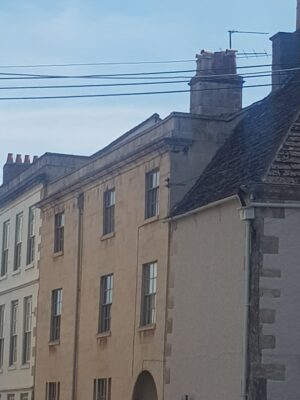
The Conservation officer made the following observations…
The proposal would have limited impact on the significance of the Chippenham Conservation Area, being located at high level and on the rear roof slope, there is also limited vantage points from where this aspect of the site can be perceived.
The works in this application are considered to impact on the significance of the listed building, the impact on balance is considered to be less than substantial for the purposes of the NPPF.
Whilst normally I would be unable to support such a proposal I note that in this particular case a unique number of factors have been addressed within the context of the application.
- The roof is a modern construction, the existing covering is modern and has no evidential value as a result
- The roof is concealed from public view and the PV array is confined to the existing plain of the roof preserving the existing roof profile
- The timbers of the roof underneath are retained unaffected by the replacement outer covering.
- There are no significant issues raised by the structural engineer in terms increased loading on the building fabric or need additional strengthening works within the roof to accommodate the PV array.
In view of the global climate emergency one cannot ignore the potential benefits of the scheme though in such cases we have not been provided with an energy audit to detail the full benefits of the scheme in carbon saving or explain other measures that have been explored to reduce the overall energy consumption in this case.
The application was subsequently approved and in the decision statement the following climate statement has been included.
Climate Change.
Wiltshire Council acknowledges the climate emergency and is seeking to make the county carbon neutral. Adapting historic buildings for the future and making them energy efficient is a challenge and unique solutions may need to be found. Historic England provide guidance on this, including practical guidance on draught proofing, insulating and ways of generating energy. The energy saving trust provides more general information and resources on energy in homes. Also, Warm and Safe Wiltshire offers all residents across the county free and impartial telephone advice on energy saving. The developer is encouraged to contact the climate team to discuss this further: climate@wiltshire.gov.uk
Key points in this decision seem to be the use of an experienced architect and that the nature of the roof meant that panels are not easily visible.
Again a good decision.
Conservation Area Fronting the Road
A recent planning application in Park Lane, Chippenham, for solar panels fronting the road unfortunately led to a refusal by Wiltshire Council (March 2024). Though the Town Council supported the application, the Wiltshire Conservation officer had put in an objection based on the visual character of the road and the ‘alien’ appearance of the solar panels. This had also been highlighted by the Town Council planning officer comments, though the Town Council had nonetheless supported the application.
It appears that in this case the decision is finely balanced. If the application had included more heritage information, and how the roof might be protected or restored at end of life then it might have tipped in favour. If the panels chosen were recessed into the roof, or especially if solar tiles were used, then that may have also tipped the application in favour of approval. But how far can you reasonably expect a domestic installation to go with regards planning detail?
It appears that recent guidance from RIBA regarding heritage buildings considers that solar panels mainly benefit the individual household and recommend giving priority to other energy saving measures.
From Zero Chippenham’s perspective this doesn’t recognise the need to rapidly build out solar in Wiltshire and the changing nature of the grid and creation of micro-grids. If solar panels were installed in houses along Park Lane it could become the start of ‘internet of energy’ that we need to build towards 2040 to reach our climate goals. It’s understood the applicant may appeal.
Conclusion
In conclusion I believe we have reached a tipping point in terms of planning applications for Solar PV on listed buildings in the Chippenham Conservation area in favour of approving the application in many cases. Though it should be noted that in all three supported cases the services of an experienced architect has been used, and each application was assessed on its own merit.
In the case of refusal on Park Lane the panels were non recessed, fronted the road, and were objected to on the character appraisal of the street. A more sympathetic design or involvement of an architect may have led to approval, but it was a finely balanced, and from a renewable energy perspective disappointing decision.


